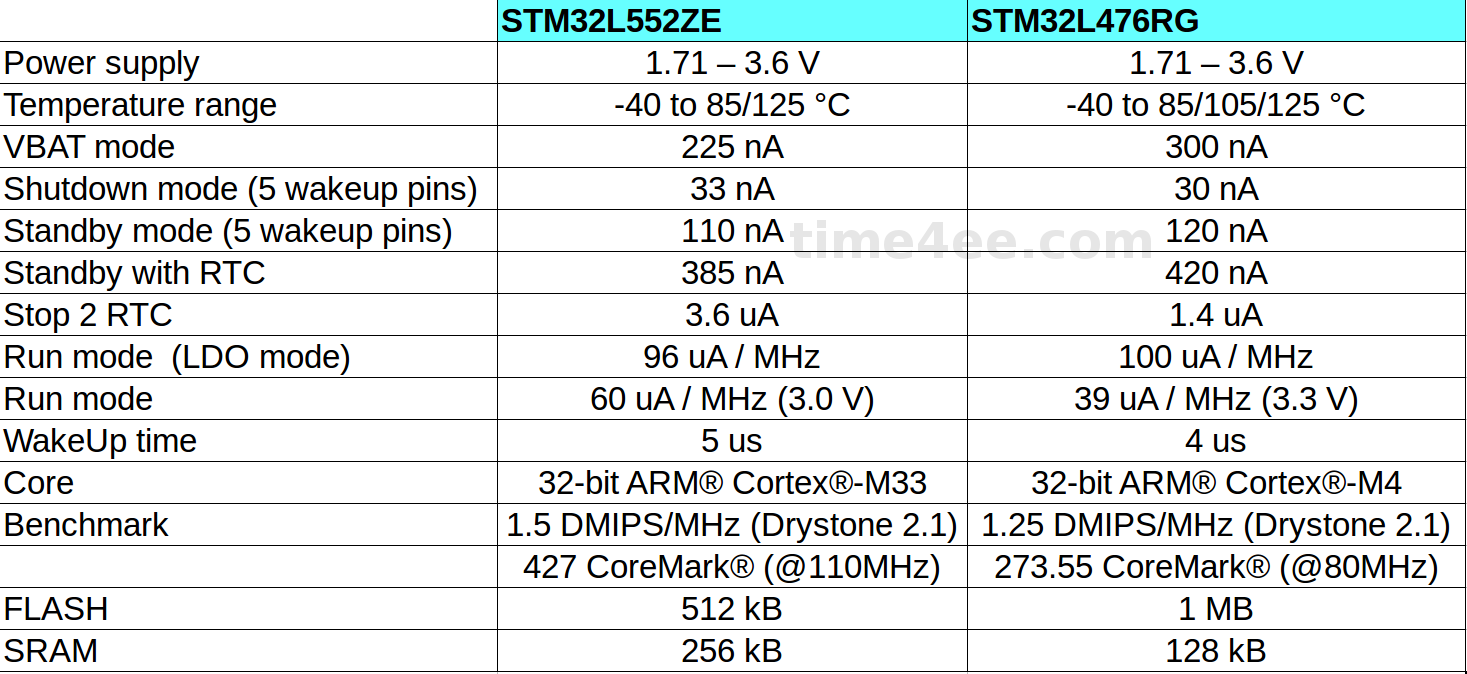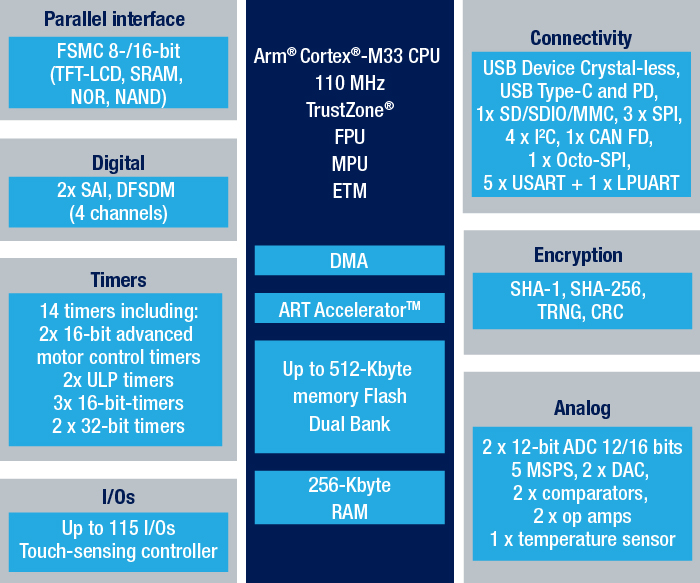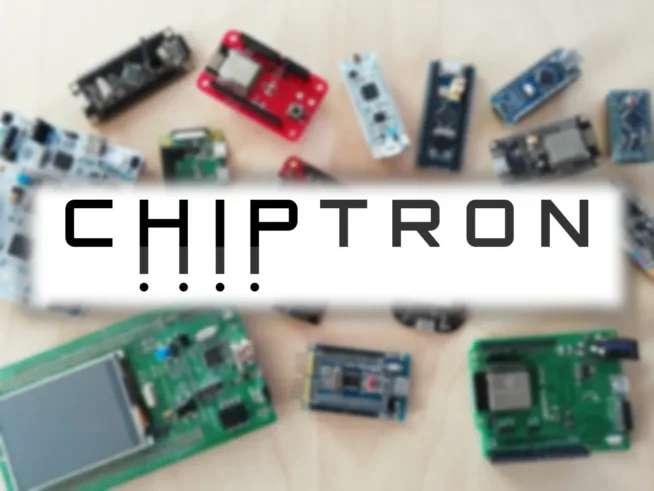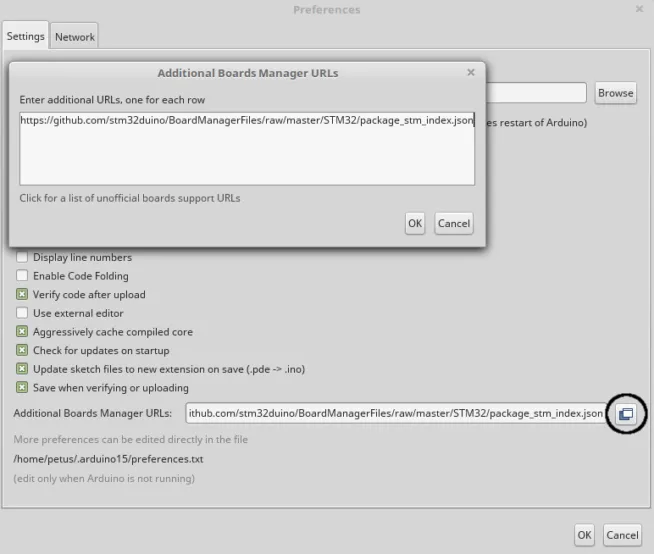The STM32 family of ultra low-power microcontrollers made by STMicroelectronics welcomed a new line of ultra low-power microcontrollers called STM32L5.
The most siginificant change is using of different ARM Core. STM32L5 contains ARM Cortex-M33 instead of Cortex M0+ and M4.
The M33 core is designed specially for IoT application and application with high level of security.
In this time, the STM32L5 line contains two types of microcontrollers (in a few various –
STM32L552 a STM32L562. L562 contains extra PKA (Private key accelaration) and AES (128/256 bit).
There is brief comaprison of STM32L552 and STM32L476
Specification of STM32L552
Ultra-low-power with FlexPowerControl
1.71 V to 3.6 V power supply
-40 °C to 85/125 °C temperature range
Batch acquisition mode (BAM)
225 nA in VBAT mode: supply for RTC and 32×32-bit backup registers
33 nA Shutdown mode (5 wakeup pins)
110 nA Standby mode (5 wakeup pins)
385 nA Standby mode with RTC
3.6 ?A Stop 2 with RTC
96 ?A/MHz Run mode (LDO mode)
60 ?A/MHz Run mode @ 3 V (SMPS step down converter mode)
5 ?s wakeup from Stop mode
Brownout reset (BOR) in all modes except shutdown
Core
Arm® 32-bit Cortex®-M33 CPU with TrustZone® and FPU
ART Accelerator™
8 Kbytes instruction cache allowing 0-wait-state execution from Flash memory and external memories; frequency up to 110 MHz, MPU, 165 DMIPS and DSP instructions
Performance benckmark
1.5 DMIPS/MHz (Drystone 2.1)
427 Coremark® (3.88 Coremark®/MHz @ 110 MHz)
Energy benchmark
402 ULPMark-CP® score
59.5 ULPMark-PP® score
27400 SecureMark-TLS® score
Memories
Up to 512 Kbytes Flash, two banks read-while-write
256 Kbytes of SRAM including 64 Kbytes with hardware parity check
External memory interface supporting SRAM, PSRAM, NOR, NAND and FRAM memories
OctoSPI memory interface
General-purpose input/outputs
Up to 114 fast I/Os with interrupt capability most 5 V-tolerant and up to 14 I/Os with independent supply down to 1.08 V
Security
Arm® TrustZone® with the ARMv8-M mainline security extension
Up to 8 configurable SAU regions
ROP, secure PC-ROP, active tamper, secure firmware upgrade support
TrustZone aware and securable peripherals
Power management
Embedded regulator (LDO) with three configurable range output to supply the digital circuitry
SMPS step down converter
External SMPS support
Clock management
4 to 48 MHz crystal oscillator
32 kHz crystal oscillator for RTC (LSE)
Internal 16 MHz factory-trimmed RC (±1%)
Internal low-power 32 kHz RC (±5%)
Internal multispeed 100 kHz to 48 MHz oscillator, auto-trimmed by LSE (better than ±0.25% accuracy)
Internal 48 MHz with clock recovery
3 PLLs for system clock, USB, audio, ADC
Up to 16 timers and 2 watchdogs
16x timers: 2 x 16-bit advanced motor-control, 2 x 32-bit and 5 x 16-bit general purpose, 2x 16-bit basic, 3x low-power 16-bit timers (available in Stop mode), 2x watchdogs, 2x SysTick timer
RTC with HW calendar, alarms and calibration
Up to 19 communication peripherals
1x USB Type-C™/ USB power delivery controller
1x USB 2.0 full-speed crystal less solution, LPM and BCD
2x SAIs (serial audio interface)
4x I2C FM+(1 Mbit/s), SMBus/PMBus
6x USARTs (ISO 7816, LIN, IrDA, modem)
3x SPIs (7x SPIs with USART and OctoSPI in SPI mode)
1xCAN FD controller
1x SDMMC interface
2 DMA controller
14 DMA channels
Up to 24 capacitive sensing channels:
Support touch key, linear and rotary touch sensors
Rich analog peripherals (independent supply)
2x 12-bit ADC 5 Msps, up to 16-bit with hardware oversampling, 200 ?A/Msps
2x 12-bit DAC, low-power sample and hold
2x operational amplifiers with built-in PGA
2x ultra-low-power comparators
4x digital filters for sigma delta modulator
True random number generator
CRC calculation unit
HASH (SHA-256) hardware accelerator
Debug
Development support: serial wire debug (SWD), JTAG, Embedded Trace Macrocell (ETM)
96-bit unique ID
The start of mass production is planned from Q2 2019.
The microcontrollers STM32L5 will be available in these packages: LQFP48, UFQFN48, LQFP64, WLCSP81, LQFP100, UFBGA132, LQFP144.
So, we can probably expect development board like Nucleo 64, Nucleo 144 and also Discovery.
More info is available on https://www.st.com/en/microcontrollers/stm32l5-series.html
Press Release: https://www.st.com/content/st_com/en/about/media-center/press-item.html/p4087.html






